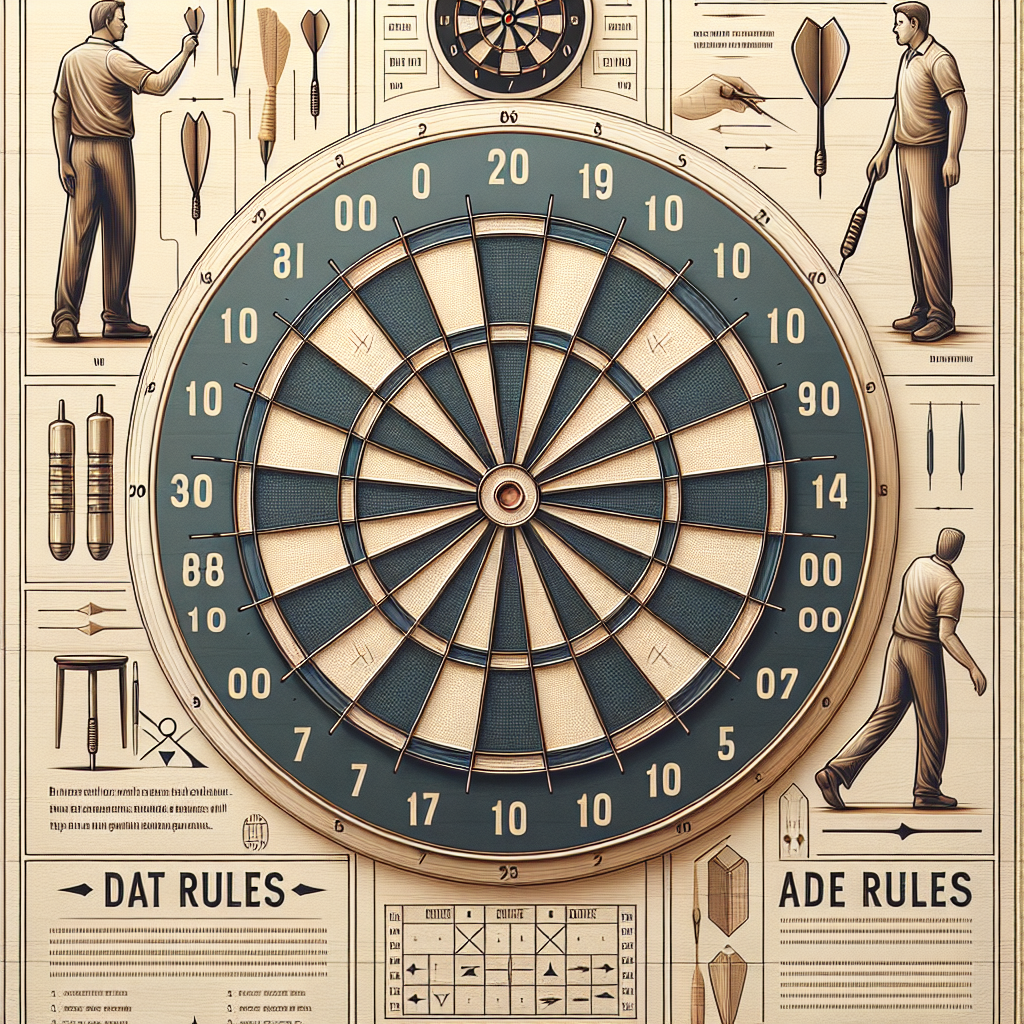Basics of Dart Games
Before diving into the specific rules of cricket dart game, it’s important to understand the basics of dart games in general. This includes familiarizing yourself with different dart game formats and knowing how to set up the dartboard and use the necessary equipment.
Understanding Dart Game Formats
Dart games come in various formats, each with its own set of rules and objectives. One popular format is the “501 up” game, commonly played in professional matches. In this format, each player starts with a score of 501 and takes turns throwing 3 darts. The objective is to be the first player to reduce the score to exactly zero, with the last dart thrown needing to land in a double or the bullseye. Other common dart game formats include “301” and “baseball.” To learn more about different dart game formats, visit our article on dart game rules.
Dartboard Setup and Equipment
To play any dart game, you’ll need a dartboard and the appropriate equipment. The standard height for a dartboard is 1.73m (5 feet, 8 inches) above the ground, with players standing behind an “oche” 2.37m (7 feet, 9 and 1/4 inches) away from the front of the board. Each player typically throws three front-weighted darts during their turn.
The most commonly used design for a dartboard is the “clock” or “trebles” board, known as a “bristle board.” This board consists of a circle divided into 20 segments, numbered from 1 to 20, with a bullseye at the center and a thin red ring called the 25 ring surrounding it. For more information about dartboard design and variants, check out our article on popular dart games.
To play dart games, it is crucial to use high-quality darts that suit your throwing style and grip. Darts typically consist of a barrel, a shaft, and a flight. The barrel is the main part that you hold and throw, while the shaft and flight help stabilize the dart during flight. It’s important to find darts that feel comfortable in your hand and provide a balanced throw.
Now that you have a solid understanding of the basics of dart games, it’s time to explore the specific rules and strategies of cricket dart game. In the next section, we will dive into the objective, scoring, and strategic aspects of cricket darts.
Cricket Dart Game Rules
Cricket is a popular and challenging dart game that requires precision and strategy. In this section, we will explore the objective of cricket darts, the scoring system, and some key strategies and tactics to help you excel in the game.
Objective of Cricket Darts
The objective of cricket darts is to hit the numbers 20 through 15 and the bullseye three times. Each time you hit a number three times, that number becomes “closed” for you. The ultimate goal is to close each number before your opponent or the opposing team, which provides you or your team with the opportunity to earn points.
Scoring in Cricket Darts
In cricket darts, hitting the 20 area three times makes it yours. Additionally, hitting a triple earns three marks, while hitting a double earns two marks. Once a number is closed, you can continue scoring in that area. It’s important to note that an area can be “closed” by your opponent, so it’s crucial to score as much as possible before that happens.
Strategy and Tactics in Cricket Darts
One of the key tactics in cricket darts is deciding whether to focus on closing your opponents’ numbers or getting more points from your own numbers. This strategic decision-making is considered the fun part of the game.
Here are a few strategies and tactics to consider in cricket darts:
- Closing Numbers: Prioritize closing your opponents’ numbers to prevent them from earning points. By focusing on closing their numbers, you limit their scoring opportunities and gain an advantage.
- Points Accumulation: Score as many points as possible in your own numbers before they are closed by either you or your opponent. This strategy allows you to accumulate points and potentially secure victory even if your opponent closes their numbers first.
- Strategic Play: Take calculated risks by aiming for high-scoring areas like triples or doubles to maximize your points. However, be mindful of the possibility of missing and wasting your turn.
- Defensive Play: If your opponent is close to closing their numbers, consider strategically targeting those areas to block their progress and force them to focus on reopening numbers rather than scoring points.
Remember, cricket darts is a dynamic game that requires adaptability and quick thinking. The strategic decisions you make during the game can turn the tide and lead you to victory, even if the round limit hasn’t been reached or all areas haven’t been opened.
Understanding the objective, scoring system, and employing effective strategies and tactics will enhance your performance in cricket darts. Practice, patience, and a keen eye for precision will help you rise to the challenge and master this exciting dart game.
Cricket Darts Gameplay
In the thrilling game of cricket darts, understanding the gameplay is essential to secure victory. Let’s explore the turn structure, scoring system, and how to emerge triumphant in a cricket darts match.
Turn Structure in Cricket Darts
In cricket darts, players take turns throwing three darts each. The objective is to hit the numbers 20 through 15 and the bullseye three times. By hitting a number three times, the number becomes closed. The goal is to close each number before your opponent or the opposing team, providing you or your team with the opportunity to earn points.
During their turn, players aim to hit the target numbers and bullseye to close them. Each player has three darts to achieve this objective. Hitting the outer ring of a number counts as two, while hitting the inner ring closes the number (Shot Darts).
Keeping Score in Cricket Darts
Scoring in cricket darts is based on hitting the opponent’s unclosed numbers. When a player hits the opponent’s unclosed number, they receive the points associated with that particular number. For example, hitting a 17 would award 17 points. Scoring points continues until all numbers are closed by a particular player. The outer ring of the bullseye is worth 25 points, while the inner bullseye grants 50 points to the player or team (Shot Darts).
Winning a Cricket Darts Match
The ultimate goal in cricket darts is to close all the numbers before your opponent or opposing team. Once a player has closed all the numbers, they can accumulate points by hitting the opponent’s unclosed numbers. The player or team with the most points and all their numbers closed emerges as the victor in the cricket darts match (Shot Darts).
By understanding the turn structure, scoring system, and the objective of cricket darts, you can strategically plan your throws and aim to close numbers efficiently. Remember, the player or team with the highest score and all numbers closed emerges as the winner in this exhilarating game of cricket darts.
Advanced Cricket Dart Techniques
To truly excel in the game of cricket darts, players can employ various advanced techniques to gain a competitive edge. This section will explore notable outshots, effective darting strategies, and the art of mastering the triple shot.
Notable Outshots in Cricket Darts
In cricket darts, achieving high outshots can be a game-changer. Here are some notable outshots that players can aim for:
| Outshot | Combination |
|---|---|
| 170 | T20, T20, Double Bull |
| 164 | T20, T18, Double Bull or T19, T19, Double Bull |
| 160 | T20, T20, Double 40 |
| 152 | T20, T20, Double 16 |
| 130 | T20, T20, Double 5 |
These outshots require precision and skill, and hitting them can turn the tide of the game. Keep in mind that these are just a few examples, and there are countless other combinations that can lead to successful outshots.
Effective Darting Strategies
Successful darting in cricket darts involves more than just hitting high scores. It requires strategic thinking and careful planning. Here are some effective strategies to consider:
-
Targeting the opponent’s weak areas: Pay attention to the areas where your opponent is struggling to score points. By consistently hitting those areas, you can put pressure on them and gain an advantage.
-
Strategic point accumulation: Focus on accumulating points strategically. Aim for the numbers that will give you an advantage in closing them out, such as hitting the triple of a number that your opponent hasn’t closed yet.
-
Strategic use of the bullseye: The bullseye is a valuable target in cricket darts. It can help you accumulate points quickly and also provide opportunities for outshots. Aim for the bullseye when it makes strategic sense.
-
Mind games: Psychological tactics can play a role in cricket darts. Creating doubt in your opponent’s mind by consistently hitting high scores or by strategically closing numbers can give you an advantage.
Mastering the Triple Shot
The triple shot is a fundamental skill that every cricket darts player should aim to master. Hitting the triple segment of a number not only accumulates points quickly but also helps in closing out numbers faster. Here are some tips to improve your triple shot:
-
Consistent stance and grip: Develop a consistent stance and grip that allows for a smooth and controlled dart throw. This will help you maintain accuracy and increase the chances of hitting the triple segment.
-
Focus on the target: Keep your eyes fixed on the target, specifically the triple segment of the number you are aiming for. Visualizing the target and focusing your attention on it will improve your aim and accuracy.
-
Practice and repetition: The key to mastering the triple shot is practice. Regularly practice hitting the triple segment of different numbers to develop muscle memory and improve your consistency.
-
Adjustment and adaptation: Every dartboard is unique, and the positioning of the triple segments may vary slightly. Adapt to the specific dartboard you are playing on and make minor adjustments to your aim accordingly.
By incorporating these advanced techniques into your gameplay, you can elevate your performance in cricket darts. Remember, practice and experience are essential in honing these skills, so keep throwing those darts and enjoy the journey towards becoming a skilled cricket darts player.
Other Popular Dart Games
While cricket dart game rules are widely known and enjoyed, there are many other dart games that offer unique challenges and excitement. Let’s explore a few popular dart games that you might find interesting.
Killer Dart Game Overview
The game of Killer is a thrilling and competitive dart game that tests players’ accuracy and strategy. In this game, each player is allocated a number on the dartboard. The objective is to hit your allocated number to score lives. Hitting a double on your number scores 2 lives, while hitting a treble scores 3 lives.
Once a player accumulates 5 lives, they become a “killer.” As a killer, you have the power to deduct lives from other players by hitting their allocated numbers. The last player left in the game is the ultimate winner. Killer is a fast-paced and competitive game that requires both accuracy and strategic decision-making.
Professional Dart Matches
In the world of professional darts, the most common game played is “501 up.” This game is often seen in tournaments and televised events. In 501, players start with a score of 501 and take turns throwing 3 darts each. The objective is to be the first player to reduce the score to exactly zero, with the last dart thrown needing to land in a double or the bullseye (Masters of Games).
Professional dart matches are highly competitive and showcase the skills and precision of the players. The pressure of performing under the spotlight adds an extra layer of excitement to the game. Watching professional dart matches can be inspiring and provide valuable insights into advanced dart techniques.
Dartboard Design and Variants
The design of a dartboard plays a significant role in the game of darts. The most commonly used design today is the “clock” or “trebles” board, often referred to as a “bristle board.” This board is made from vegetable fiber and consists of a circle of 20 segments, numbered from 1 to 20. The board also features a bullseye at the center and a thin red ring called the 25 ring surrounding it (Masters of Games).
While the clock or trebles board is the standard design, there are also variations and alternative dartboard designs available. Some variants feature different scoring systems or unique patterns on the board. Exploring these different dartboard designs can add a new level of excitement and challenge to your dart games.
By trying out different dart games like Killer, observing professional matches, and exploring various dartboard designs, you can expand your dart-playing experience and find new ways to enjoy this popular sport. Remember, each game has its own set of rules and strategies, so be sure to familiarize yourself with the specific rules of each game before jumping in.







